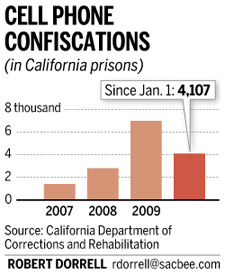
Contraband smuggled into prisons has been a headache for jailers since the days of baking files into cakes.
But state prison officials say thousands of cell phones making their way into the hands of inmates are creating serious new security problems.
They get inside in myriad ways - hidden in deodorant sticks, basketballs and cans of food, or smuggled in by staffers for a price.
The devices, including sophisticated smart phones and even wrist watch phones, give inmates access to criminal associates on the outside and to the Internet, which prisoners use for social networking, credit card fraud, and even to see if new arrivals are on the Megan's List website.
"Since 2006, it's just been gradually building, but this last year it exploded," said Lt. Doug Snell at Avenal State Prison in Kings County, where 382 cell phones have been discovered so far this year among the 6,654 inmates there.
Statewide, prison officials have found 4,107 phones since Jan. 1, corrections spokesman Paul Verke said, putting the state on pace for another record year in cell phone seizures.
Last year, 6,995 cell phones were discovered, up from about 2,800 in 2008 and 1,400 the year before that.
"It's a huge problem," said Richard Subia, deputy director of the corrections department. "I consider it one of the priority issues right now with regard not only to our safety in the prisons, but to public safety."
Part of the increase stems from technology, officials say. The smaller phones get, the easier they are to hide.
But there is another factor complicating the issue: It's not illegal for an inmate to possess a cell phone or for someone to smuggle one into a prison.
Inmates can be punished with the loss of 30 days of good-time credits and staffers can be disciplined and fired, but efforts to pass legislation making it a crime so far have failed.
One bill pending in the Legislature would make it a misdemeanor to bring phones into a prison, and a bill that makes it illegal for inmates in federal prisons to possess phones has passed through Congress and awaits President Barack Obama's signature.
Meanwhile, prison officials find themselves using a variety of means to detect the phones, from cell searches to specially trained dogs to highly sophisticated tracking devices.
Subia said state corrections officials are studying the cost of implementing airport-style searches of everyone - staff, vendors and visitors - entering prisons rather than just focusing on visitors.
Last year, Subia said, 300 investigations were launched into cases involving contraband being brought in by staffers.
One correctional officer was found at California State Prison, Solano, to be smuggling cell phones in, Subia said, and during questioning he indicated that in addition to his salary he had earned $100,000 in just one year for bringing inmates phones and tobacco.
"There was nothing we could do other than fire him," Subia said.
Many phones are found through searches of visitors and staffers entering a prison. Others have been found after they were dropped off on prison grounds outside the fence for members of inmate work crews to pick up.
It's not unusual for the phones to be dropped off with other contraband.
"We've found Rogaine, DVD players, whatever they are wanting," Snell said. "It's basically place your order, and the hot items are phones, tobacco and drugs."
The use of cell phones in prisons nationwide has been linked to escapes, a "hit" ordered on a witness in Maryland, even a phone threat to a legislator from a Texas death row inmate.
At Avenal State Prison, an inmate using a cell phone camera managed to take video of an inmate disturbance and post video of it on the Internet.
Others have joined social networking sites using contraband cell phones with Internet capability, Snell said.
But the security problems the phones pose are the biggest concern.
Before the presence of cell phones, if an inmate developed a problem that placed him in danger, he could be moved to another part of the prison for safety.
"Now, the inmates just simply call the other yard, and they know he's coming before we get him there," Snell said. "We'll walk him into the yard and there's someone standing there waiting."
Prisons nationwide are facing the problem and have used a variety of approaches to combat it. At Avenal and some other California prisons, specially trained dogs that can sniff out materials used in phones help find them.
That program is being expanded, and there have been tests of other methods of detection.
One device from ITT Defense known as "Cell Hound" electronically detects phones inside prisons.
That system uses sensors that ITT says can pinpoint the location of any cell phone that is in use or simply turned on.
"It gives you the chance to recover the cell phones and pull the (SIM) card out and gain a lot of security intelligence," said John Shaffer, an ITT consultant and former Pennsylvania prisons official.
But, for now, the use of dogs and investigative staff are the most promising methods in California.
Snell said inmates pay from $300 to $1,000 or more for phones - typically ones with prepaid minutes - but that the price is going up because of the increase in confiscations now that dogs are being used to help find them.
But inmates have a seemingly inexhaustible way of having phones delivered.
"They've had cell phones come over the walls in sporting goods balls, duffel bags dropped off, just a variety of methods," said Verke, the corrections spokesman.
"It's like takeout, but it's not pizza."











